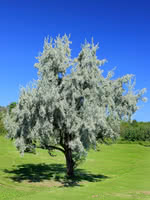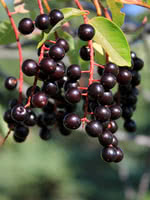Mon-Fri 9am - 5pm Mountain time
Russian Olive vs Western Chokecherry
Elaeagnus angustifolia
Prunus virginiana var. demissa
Russian Olive is a medium-sized deciduous tree that has attractive silvery coloured foliage with small yellow flowers that emit a fragrant sweet smell.
It is drought and salt tolerant, and works well as a shelterbelt species. Russian Olive can also be used to combat erosion.
Note: although Russian Olive is planted as an attractive boulevard tree in many northern areas, in warmer areas it can invade watersheds and is considered invasive. Please do some research and plant the right tree in the right place.
Western Chokecherry is a shrub or small tree commonly used for farmstead and field windbreaks.
It produces white flowers in the spring and edible dark purple fruit that matures between September and October. Its cherries are great for making for making jams, jellies or wine, but are not very palatable for raw eating.
Russian Olive Quick Facts
Western Chokecherry Quick Facts
Toxicity: toxic to horses, cattle, etc.)
In row spacing: 1.8 - 2.4 m (6 - 8 ft)

